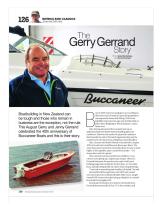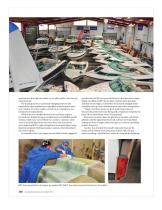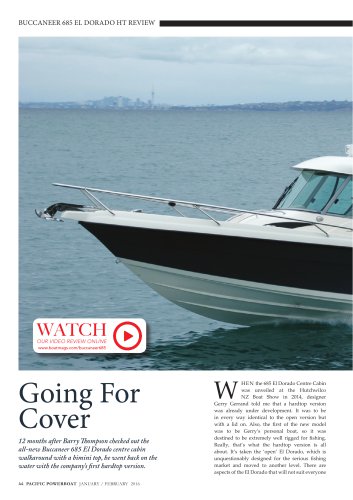
Catalog excerpts

RETROS AND CLASSICSJOHN MACFARLANE Photos John Macfarlane and Gerry Gerrand Boatbuilding in New Zealand can be tough and those who remain in business are the exception, not the rule. This August Gerry and Jenny Gerrand celebrated the 40th anniversary of Buccaneer Boats and this is their story. Born in f 949, Gerry Gerrand grew up on a Waikato dairy farm and, through his paternal grandfather, was exposed to boats and fishing. This left an indelible impression: by age nine he'd decided on ei ther boa t designing or bee farming as a career. Boats won. After leaving school i n 1964, Gerrand took up an apprenticeship with Kollo’s Marine building plywood runabouts. However the market for plywood runabouts died towards the end of Gerrand’s apprenticeship and he transferred to the showroom selling boats and chandlery. After 12 years with Hollo’s Marine, Gerrand left in August 1976 to found what would become Buccaneer Boats. The name Buccaneer came from Gerrand’s desire to have a name higher in the alphabet, plus it suited his attit ude - "I’ve always been a bit of a pirate.” Now married to Jenny and with two children, it was a brave move giving up a regular pay cheque. However, Gerrand had spent the previous two-and-a-half years building plugs and moulds for his first boat, a 4,7m cabin boat, typically designed by eye rather than using drawings. “I can look at something and visualise it finished,” he said. Gerrand had little experience with GRP and, armed with some tips from surfboard builder Mike Court, taught himself GRP construction by laying up dinghies in a mould borrowed from EpiglassNZ. Setting up his business in a shed on the family farm, Gerrand demonstrated his First 4.7 to four retailers and
Open the catalog to page 1
came away with four orders. Incidentally, one of those dealers, Roger’s Boa t Shop, is still a Buccaneer dealer today. The 4.7, and its bigger brother the 4.9, would prove extremely popular models and Gerrand would eventually build nearly 500 of them. Initially finishing one boat a month was considered good progress, but as demand increased, production ramped up to two per week. The first eight boats were entirely hand laid GRP before Gerrand bought himself a chopper gun and taught himself how to use it. "Some people say hand laid GRP is better [compared to a chopper gun) but I’d dispute...
Open the catalog to page 2
appointment through their dealer or the office rather than turn up unannounced. The boating market is constantly changing and Gerrand responds by ensuring Buccaneer produces something new eacli year, whether it’s a new model, a refresh of an existing one. ora construction improvement. While some new models develop from customer requests, Gerrand isn't afraid to bring out models such as the Billfish and El Dorado, which have created their own markets. Likewise, while some of his building innovations have been relatively minor, such as getting BEP to make wiring looms and switching or...
Open the catalog to page 3
customer requests which he knows will cause problems later. “I’ve always told people what they've gotta hear, not what they want to hear. There's been occasions where I've told people that maybe a Buccaneer isn't for them.” Another significant key in Buccaneer’s success has been by diversifying into commercial property and farming. This diversification gives multiple income streams, helping bridge the inevitable ups and downs of New Zealand boatbuilding. "Many boatbuilders diversify into other marine products, but to me that’s not diversification," he said. However, it's not all plain...
Open the catalog to page 4All Buccaneer catalogs and brochures
-
Brochure 2
4 Pages
-
Brochure 1
12 Pages
-
Spicy Rib
7 Pages
-
Going For Cover
5 Pages
-
Classy Crossover
7 Pages
-
650 ESPRITE
4 Pages
-
Buccaneer El Dorado
5 Pages
-
530 Esprite XL
5 Pages
-
525 & 530 Exess
3 Pages
-
Buccaneer Brochure
16 Pages










